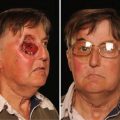Fig. 4.1
Detection of high-risk HPV using RNAscope. Multiple nuclear dot-like signals are present in the neoplastic cells whilst the stromal cells are unlabeled
Table 4.1
The performance of RNAscope in testing oro-pharyngeal squamous cell carcinomas
Diagnostic test | Sensitivity (%) [95 %CI %] | Specificity (%) [95 %CI %] | PPV (%) | NPV (%) |
|---|---|---|---|---|
HR-HPV RNAscope | 97 [84–99] | 93 [82–98] | 91 | 98 |
p16 IHC | 97 [85–99] | 82 [67–91] | 80 | 97 |
HR-HPV DNA ISH | 94 [80–98] | 91 [79–96] | 89 | 95 |
Combined p16/HR-HPV DNA ISH | 94 [80–98] | 91 [79–96] | 89 | 95 |
DNA qPCR | 91 [76–97] | 87 [74–94] | 83 | 93 |
Combined p16/DNA qPCR | 91 [76–97] | 93 [82–98] | 91 | 93 |
There is accumulating evidence that HPV positive oro-pharyngeal carcinomas have a better prognosis than HPV negative tumours [2, 9]. However, whole genome and whole exome sequencing, as well as clinical factors can identify additional subgroups of HPV positive and HPV negative types, enabling more precise stratification [6].
Molecular and Cytogenetic Testing for Salivary Gland Cancers
The histopathological diagnosis of salivary gland tumours is based largely on morphological criteria, often supplemented by histochemistry to identify mucins and to a limited extent by immunohistochemistry. Gene fusions and somatic mutations have been described and have recently opened up the possibility of using targeted therapies for some salivary malignancies [1]. In addition, molecular markers can be used to refine histological diagnosis, for example the t(12;15)(q13;q25) translocation resulting in fusion of the ETV6 and NTRK3 (or other unknown partner), distinguishes secretory carcinoma from acinic cell carcinoma. Identification of this signature fusion has contributed to the evidence leading to inclusion of a new salivary tumour in the classification scheme.
Carcinoma Arising in Pleomorphic Adenoma
Invasive carcinoma that has arisen in pleomorphic adenoma (carcinoma ex PA) is most frequently high grade and often shows undifferentiated or salivary duct carcinoma patterns, though any salivary malignancy may arise. Carcinoma arising in pleomorphic adenoma may exhibit the same gene fusions as pleomorphic adenoma, including PLAG1 and HMGA2 fusions. Unfortunately, PLAG1 fusions (including cryptic fusions, [4]) are only found in a proportion of pleomorphic adenomas. Multiple copy number alterations are typically seen in high-grade carcinomas and there may be amplification of HMGA2 and MDM2. In relation to therapy for unresectable or metastatic carcinoma ex PA, molecular typing for HER2 and AR where salivary duct carcinoma arises can be performed and may inform targeted therapy.
Adenoid Cystic Carcinoma
Although slow growing, adenoid cystic carcinoma typically spreads by perineural invasion and lacks an immune stromal response. Local recurrence is common and distant metastasis may occur late in the course of the disease. The MYB-NFIB fusion is the genomic hallmark of adenoid cystic carcinoma, and activation of MYB and MYBL1 by increased copy number or proximity to other genes is thought to be the major driver. Mutation frequency in other genes is low [5]. Both KIT and EGFR may be overexpressed but are rarely mutated and therapy against these tyrosine kinase inhibitors is not effective.
Mucoepidermoid Carcinoma
The biological behaviour of mucoepidermoid carcinoma has a broad spectrum and histological grading has prognostic utility (WHO in press). The hallmark genomic events in mucoepidermoid carcinoma are translocations involving the transcriptional coactivator genes MAML2 and CRTC1/3. Additionally, mutations of HRAS have been found in around 20 % of mucoepidermoid carcinomas, most often in high grade tumours. Mucoepidermoid carcinomas that are MAML2-CRTC1/3 fusion positive have a more favourable outcome than fusion negative tumours [3]. Genomic studies can subdivide fusions positive mucoepidermoid carcinomas into two subgroups; those with a low copy number have a good prognosis whilst those with numerous copy number alterations pursue an aggressive clinical course and show poor outcomes. Precise histological classification of high grade salivary carcinomas is difficult and some MAML2 and CRTC1/3 fusion negative carcinomas that were currently classified as poorly differentiated mucoepidermoid carcinoma may in reality fit better into the adenocarcinoma NOS type.
Stay updated, free articles. Join our Telegram channel

Full access? Get Clinical Tree






